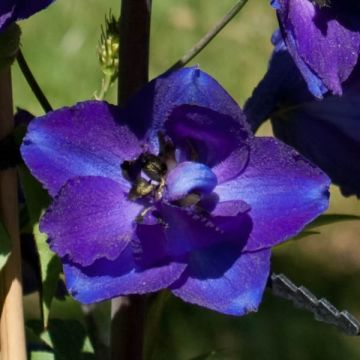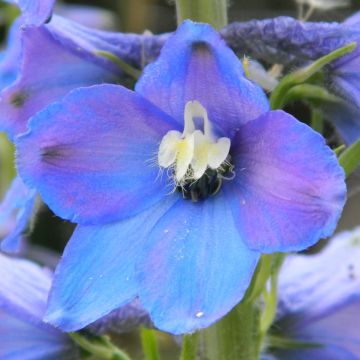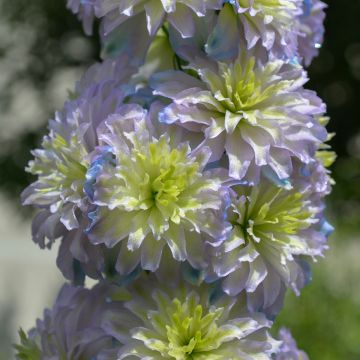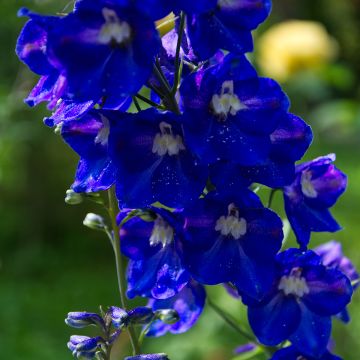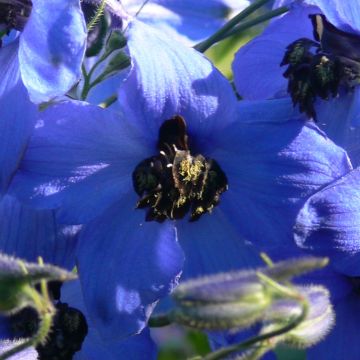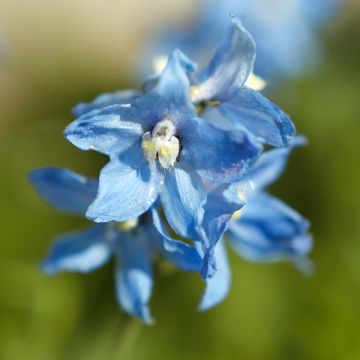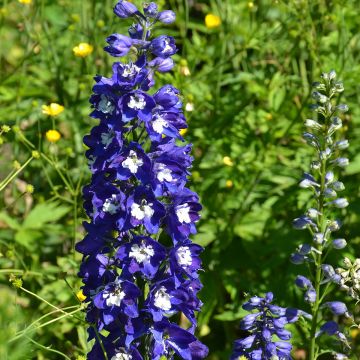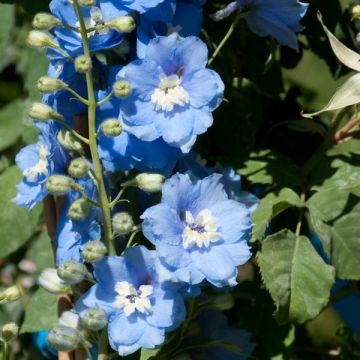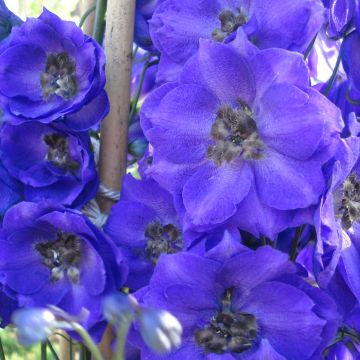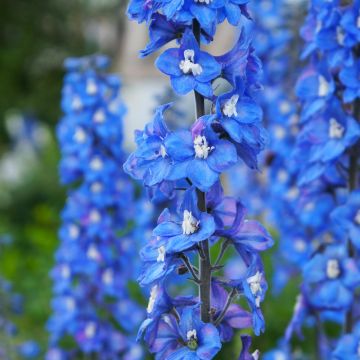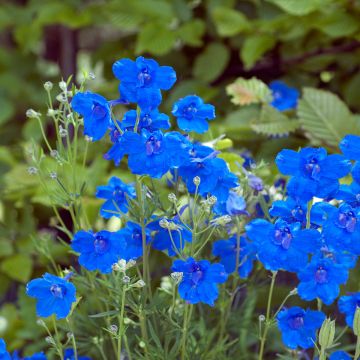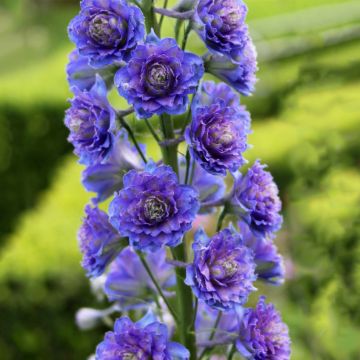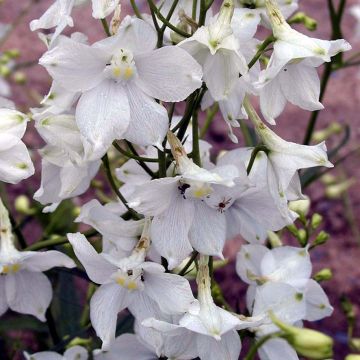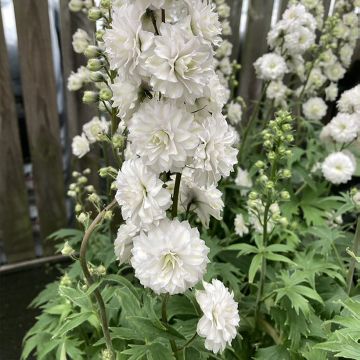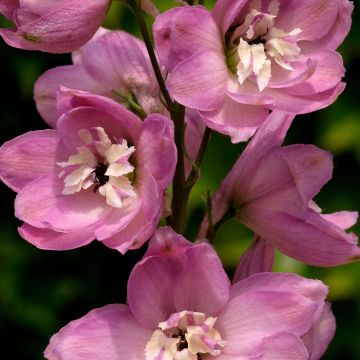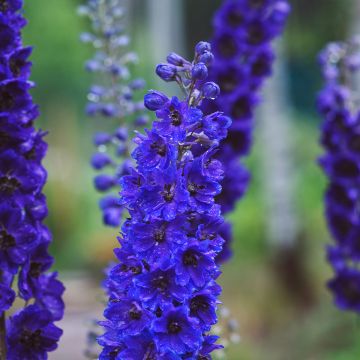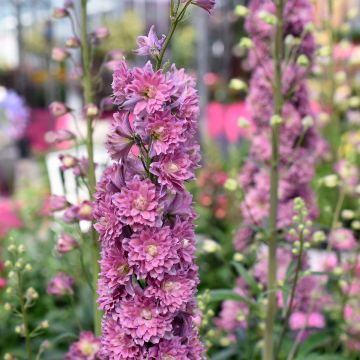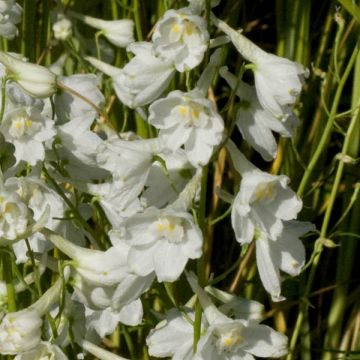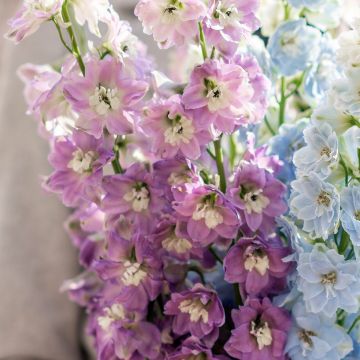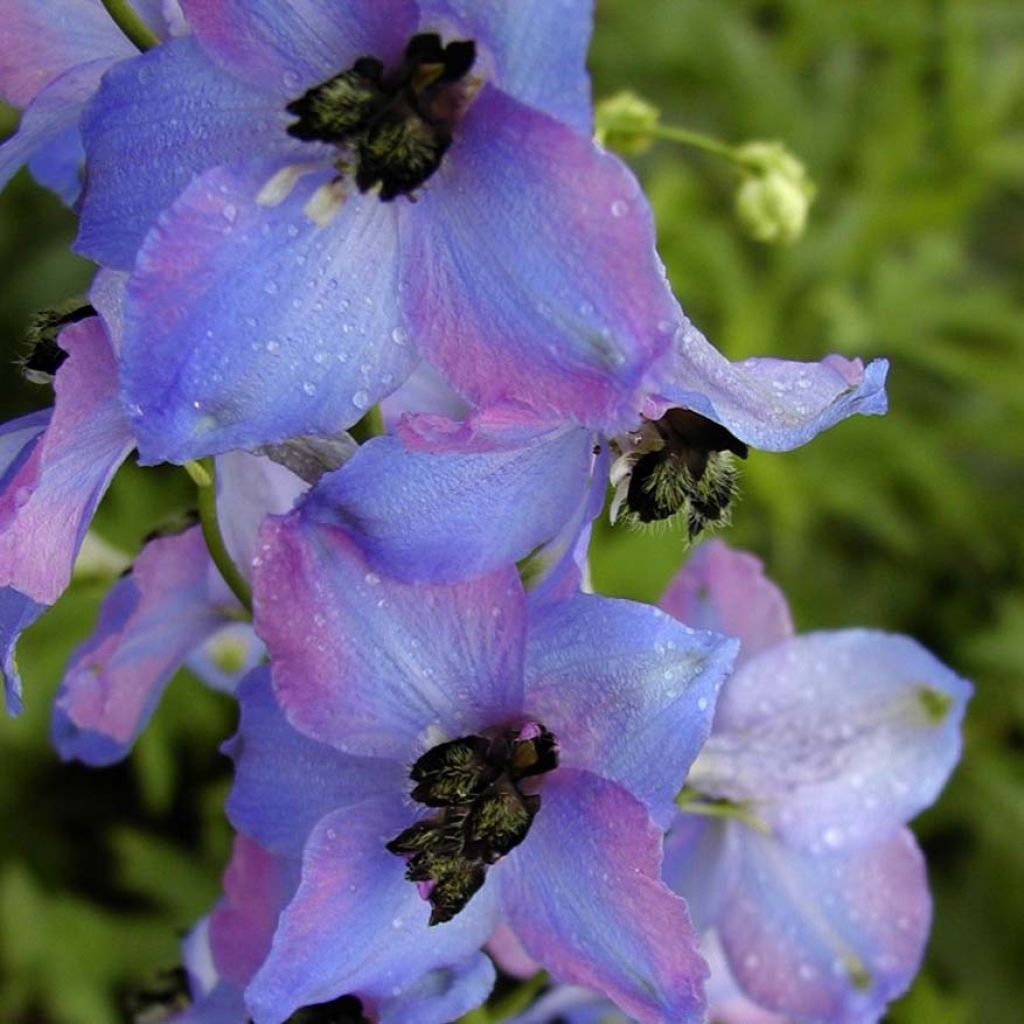

Delphinium Ouvertüre - Pied d'Alouette vivace
Delphinium Ouvertüre - Larkspur
Delphinium Pacific-hybrid Ouvertüre
Larkspur, Perennial Larkspur
Why not try an alternative variety in stock?
View all →This plant carries a 12 months recovery warranty
More information
We guarantee the quality of our plants for a full growing cycle, and will replace at our expense any plant that fails to recover under normal climatic and planting conditions.
From €5.90 for pickup delivery and €6.90 for home delivery
Express home delivery from €8.90.
Does this plant fit my garden?
Set up your Plantfit profile →
Description
Delphinium Ouverture has large spikes of medium blue flowers with pink highlights and a black heart. Its spectacular flowering lasts for 2 months during the summer if the soil is rich and moist. This imposing plant has rapid growth but a short life.
The Pacific Delphiniums are hybrids obtained in California, remarkable for the size of their inflorescences, ranging from 1m (3ft) to 1.20m (4ft) long, carried by numerous stems reaching a height of 1.80-2m (6-7ft). The imposing steel blue spikes with black eyes of the 'Ouverture' variety are highly visited by pollinating insects. The large single flowers, formed by 5 imbricated petals with undulated edges, have a spur reminiscent of a dolphin's snout and are grouped in tight spikes along unbranched stems.
The main flowering begins in June and continues throughout the summer if you cut the faded stems quickly.
Delphiniums are decorative with their cup-shaped, single or double flowers, in long spikes.
Most of them have fibrous or fleshy roots, sometimes tuberous.
Delphiniums are floriferous herbaceous perennial plants belonging to the Ranunculaceae family, always noticeable in a garden. The 'Pacific hybrid' Delphiniums, mainly derived from Delphinium elatum, have a short life and are often grown as biennials. Delphinium elatum or tall larkspur is found in moist meadows at high altitudes in the Eastern Pyrenees and throughout the Alps in Europe, as well as in Southern Europe, Central and Eastern Europe, Siberia, Mongolia, and China.
Their imposing clump always adds volume, height, and charm to perennial borders. They are good companions for moss or gallica roses, with which they create charming and romantic scenes. The intense blue with a touch of pink of the Delphinium Ouverture forms a beautiful combination with pink or salmon daylilies and Rosenschleier gypsophila. Their flowers hold up well in bouquets. Irreplaceable in the background of romantic borders, in containers, or in large pots near the house, these robust plants thrive in sunny, rich, deep, and well-drained soils.
Note: From March to September, the stems of our delphiniums are cut short to promote better branching and achieve optimal rooting. This also prevents the stems from breaking during transport.
The name Delphinium comes from the Greek word "delphis" which means "dolphin". They are also called "larkspur". Native Americans and European settlers used them as a blue dye to make paints or ink. The juice of the flowers mixed with alum produces blue ink. Extracts from delphiniums are used in herbal medicine, especially for eye care. It seems that the oldest use of delphinium flowers was to repel scorpions.
Report an error about the product description
Delphinium Ouvertüre - Larkspur in pictures
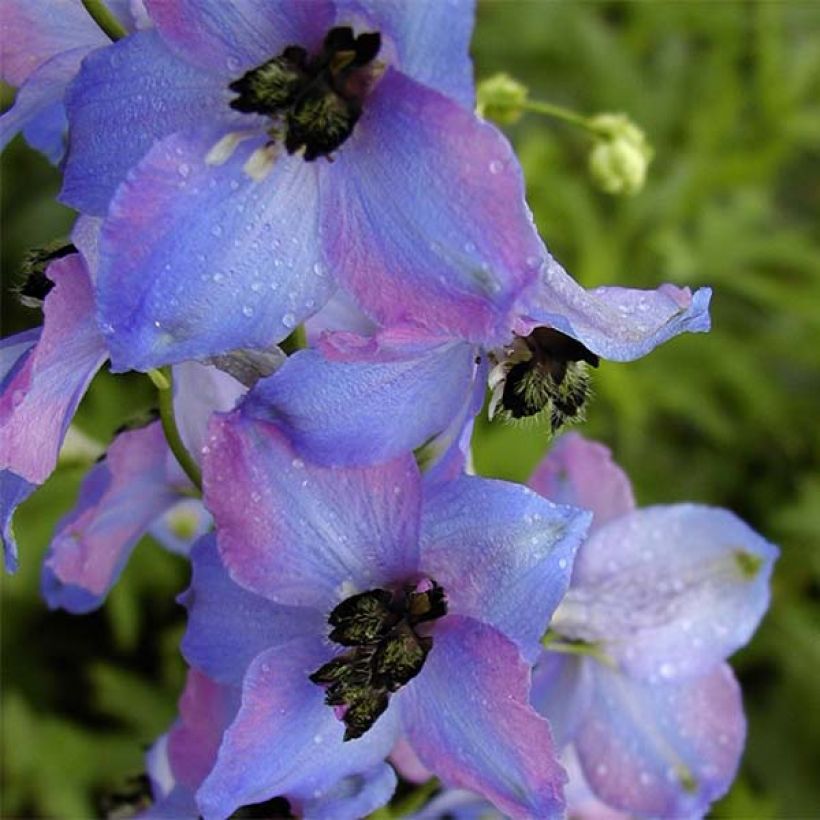

Flowering
Foliage
Plant habit
Safety measures
Botanical data
Delphinium
Pacific-hybrid
Ouvertüre
Ranunculaceae
Larkspur, Perennial Larkspur
Cultivar or hybrid
ingestion
Cette plante est toxique si elle est ingérée volontairement ou involontairement.
Ne la plantez pas là où de jeunes enfants peuvent évoluer, et lavez-vous les mains après l'avoir manipulée.
Pensez à conserver l'étiquette de la plante, à la photographier ou à noter son nom, afin de faciliter le travail des professionnels de santé.
Davantage d'informations sur https://plantes-risque.info
Other Delphinium - Larkspur
Planting and care
Cultivation is fairly easy but still requires some precautions: delphiniums dislike heavy and wet soils, as well as dry and poor soils. The soil that suits them is good black soil, rich in humus, non-compact, moist, even in summer, but not excessively wet in winter, and sheltered from strong winds. Under these conditions, they will live for many years. Also, beware of slugs that can cause damage at the beginning of growth.
Planting period
Intended location
Care
This item has not been reviewed yet - be the first to leave a review about it.
Haven't found what you were looking for?
Hardiness is the lowest winter temperature a plant can endure without suffering serious damage or even dying. However, hardiness is affected by location (a sheltered area, such as a patio), protection (winter cover) and soil type (hardiness is improved by well-drained soil).

Photo Sharing Terms & Conditions
In order to encourage gardeners to interact and share their experiences, Promesse de fleurs offers various media enabling content to be uploaded onto its Site - in particular via the ‘Photo sharing’ module.
The User agrees to refrain from:
- Posting any content that is illegal, prejudicial, insulting, racist, inciteful to hatred, revisionist, contrary to public decency, that infringes on privacy or on the privacy rights of third parties, in particular the publicity rights of persons and goods, intellectual property rights, or the right to privacy.
- Submitting content on behalf of a third party;
- Impersonate the identity of a third party and/or publish any personal information about a third party;
In general, the User undertakes to refrain from any unethical behaviour.
All Content (in particular text, comments, files, images, photos, videos, creative works, etc.), which may be subject to property or intellectual property rights, image or other private rights, shall remain the property of the User, subject to the limited rights granted by the terms of the licence granted by Promesse de fleurs as stated below. Users are at liberty to publish or not to publish such Content on the Site, notably via the ‘Photo Sharing’ facility, and accept that this Content shall be made public and freely accessible, notably on the Internet.
Users further acknowledge, undertake to have ,and guarantee that they hold all necessary rights and permissions to publish such material on the Site, in particular with regard to the legislation in force pertaining to any privacy, property, intellectual property, image, or contractual rights, or rights of any other nature. By publishing such Content on the Site, Users acknowledge accepting full liability as publishers of the Content within the meaning of the law, and grant Promesse de fleurs, free of charge, an inclusive, worldwide licence for the said Content for the entire duration of its publication, including all reproduction, representation, up/downloading, displaying, performing, transmission, and storage rights.
Users also grant permission for their name to be linked to the Content and accept that this link may not always be made available.
By engaging in posting material, Users consent to their Content becoming automatically accessible on the Internet, in particular on other sites and/or blogs and/or web pages of the Promesse de fleurs site, including in particular social pages and the Promesse de fleurs catalogue.
Users may secure the removal of entrusted content free of charge by issuing a simple request via our contact form.
The flowering period indicated on our website applies to countries and regions located in USDA zone 8 (France, the United Kingdom, Ireland, the Netherlands, etc.)
It will vary according to where you live:
- In zones 9 to 10 (Italy, Spain, Greece, etc.), flowering will occur about 2 to 4 weeks earlier.
- In zones 6 to 7 (Germany, Poland, Slovenia, and lower mountainous regions), flowering will be delayed by 2 to 3 weeks.
- In zone 5 (Central Europe, Scandinavia), blooming will be delayed by 3 to 5 weeks.
In temperate climates, pruning of spring-flowering shrubs (forsythia, spireas, etc.) should be done just after flowering.
Pruning of summer-flowering shrubs (Indian Lilac, Perovskia, etc.) can be done in winter or spring.
In cold regions as well as with frost-sensitive plants, avoid pruning too early when severe frosts may still occur.
The planting period indicated on our website applies to countries and regions located in USDA zone 8 (France, United Kingdom, Ireland, Netherlands).
It will vary according to where you live:
- In Mediterranean zones (Marseille, Madrid, Milan, etc.), autumn and winter are the best planting periods.
- In continental zones (Strasbourg, Munich, Vienna, etc.), delay planting by 2 to 3 weeks in spring and bring it forward by 2 to 4 weeks in autumn.
- In mountainous regions (the Alps, Pyrenees, Carpathians, etc.), it is best to plant in late spring (May-June) or late summer (August-September).
The harvesting period indicated on our website applies to countries and regions in USDA zone 8 (France, England, Ireland, the Netherlands).
In colder areas (Scandinavia, Poland, Austria...) fruit and vegetable harvests are likely to be delayed by 3-4 weeks.
In warmer areas (Italy, Spain, Greece, etc.), harvesting will probably take place earlier, depending on weather conditions.
The sowing periods indicated on our website apply to countries and regions within USDA Zone 8 (France, UK, Ireland, Netherlands).
In colder areas (Scandinavia, Poland, Austria...), delay any outdoor sowing by 3-4 weeks, or sow under glass.
In warmer climes (Italy, Spain, Greece, etc.), bring outdoor sowing forward by a few weeks.



































